Chapter 4. Volcanic Mountains
Day 8 – January 21 – Pátzcuaro, Michoacán
(Shari) Every travel day has its own challenges and today’s travel is no
different. However, what we anticipate does not happen and what we don’t
anticipate does. Plan B is put in effect before we even leave the campground
this morning. Yesterday, Larry asked to have the gate opened at 7 AM and, in
addition to being late, the gatekeeper opens the wrong gate. All our planning
and lining up goes up in smoke and we need to turn ourselves around to exit from
the other gate. Poor Jim planned leaving early to get propane and in the process
of changing directions, he slams his finger in the car door. I am standing right
next to him and could feel the pain.
We are traveling in convoy, but in pod order for communication purposes. I
anticipate some road changes and problems going through about three cities. All
of a sudden we see a sign that mentions a cuota road to Morelia. We are going to
Morelia and decide to take the cuota road even though it does not show in our
new atlas, nor do we have a road log for it. We are pleasantly surprised that
what once were horrendous turns and thick traffic are now bypassed. By 11:30 we
have already shaved 1 hour 45 minutes from our travel compared to last time.
Unfortunately we have to negotiate the ring road around Morelia, but the pods
communicate with each other very well and we get through the many stoplights and
crazy drivers without incident.
(Bert) Shari was not looking forward to this travel day. Other times we have
driven this part of Mexico we had great difficulties getting through San Isidro
de la Concepcion, Celaya, Salamanca and Villa de Santiago. We even had
difficulty getting out of the RV park in San Miguel. So, our road log looks like
a mice maze route. We travel as a single convoy partially separated into three
pods, anticipating many changes in the route and we keep in constant CB contact.
Amazingly, nothing is the same. A new gate makes exiting the RV park easy, a
bypass keeps us out of sight of Concepcion, we avoid Celaya altogether and make
an easy exit from the Salamanca freeway onto a well-signed toll road, so new it
is not even on the 2008-9 Mexico map and that toll road bypasses Villa de
Santiago. Nothing could be easier and we cut one and a half hours off the travel
time of 2005.
The toll road rejoins the old libra highway at Laguna Cuitzeo, the second
largest lake in Mexico and one that is crossed on a long causeway. The shallow
lake is mostly marsh on our end and loaded with birds, including dozens of Great
Blue Herons, hundreds of Great Egrets, flocks of Yellow-headed Blackbirds and
best of all a few dozen Western Grebes. We wish we could stop to bird here, but
there are no pullouts and we keep moving with the traffic.
Circling the large city of Morelia goes smoothly on the periferico, although
frequently interrupted by stoplights and heavy traffic. But the fun begins when
we arrive at out campsite in Pátzcuaro. Another caravan has taken all the spots
with utilities and the campground management misinterpreted the reservations and
thinks we are not coming. Shari jumps out of R-Pup-Tent and talks to the manager
as I pull into the open space between the two rows of parked RV’s and through
the CB and FRS radio I direct the eleven other rigs to pull off the busy highway
until we completely cover the empty space. The tailgunner for the Quebec RV tour
group wants me to leave and apparently so does the manager.
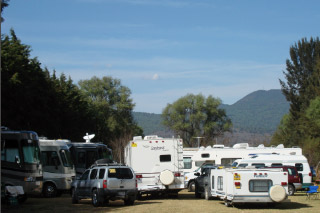 (Shari) I am thinking we are home free not realizing our hardest work is yet
to come. As we pull into the campground we notice it is full. I hop out of the
RV as Bert pulls to the far end with other rigs following. The manager tells me
to stop the caravan, it cannot come in. We do not have reservations. He shows me
his reservation sheet and I notice that the February caravan was indeed
cancelled but not ours. I try to explain this to him as he excitedly tells me to
leave. I have by now wasted enough time to allow the whole caravan off the road.
It does not look like we are going anywhere soon. We are all in the campground
and blocking every which way to Sunday. Realizing that I do not intend to tell
the caravan to leave, the manager calls his boss. I ask to talk with him. I
remember him from five years ago when he invited us to his goddaughter’s
wedding. I ask if we can park where he had the tent set up for the wedding. He
softens his attitude after I mention the wedding and says yes we can park there
if I can convince the other caravan. I am confident that I can and after I calm
down the French tailgunner from Quebec, assuring him that we will not take any
of his spaces, nor use electricity, he agrees to our parking. It would not have
mattered anyway, since Bert and Larry had begun the long process of inching us
into the spots.
(Shari) I am thinking we are home free not realizing our hardest work is yet
to come. As we pull into the campground we notice it is full. I hop out of the
RV as Bert pulls to the far end with other rigs following. The manager tells me
to stop the caravan, it cannot come in. We do not have reservations. He shows me
his reservation sheet and I notice that the February caravan was indeed
cancelled but not ours. I try to explain this to him as he excitedly tells me to
leave. I have by now wasted enough time to allow the whole caravan off the road.
It does not look like we are going anywhere soon. We are all in the campground
and blocking every which way to Sunday. Realizing that I do not intend to tell
the caravan to leave, the manager calls his boss. I ask to talk with him. I
remember him from five years ago when he invited us to his goddaughter’s
wedding. I ask if we can park where he had the tent set up for the wedding. He
softens his attitude after I mention the wedding and says yes we can park there
if I can convince the other caravan. I am confident that I can and after I calm
down the French tailgunner from Quebec, assuring him that we will not take any
of his spaces, nor use electricity, he agrees to our parking. It would not have
mattered anyway, since Bert and Larry had begun the long process of inching us
into the spots.
(Bert) Shari comes back to get her reservation form and while she deals with
the manager, I go to the end of the line to retrieve Larry so he can help me get
all of our RV’s backed into a vacant and sloped grassy hillside. We won’t have
utilities and we won’t be level except for blocking up the wheels on one side,
but at least we will have a place to park. The 1.5 hours we gained in travel
time is consumed in parking time as we jockey the vehicles back and forth,
rearranging a few times because RV’s can’t get leveled, and packing them tightly
side by side so all can find a place for the night. The Quebec tailgunner keeps
reminding me he wants one parking space for the bus that has their group out on
tour. I don’t see why the 50-passenger bus cannot park where we temporarily
parked between their vehicle rows or even out beyond the gate, but he insists.
When the Quebec wagonmaster arrives with the bus, he is much more congenial and
accommodates us cheerfully and also tells us the bus will not be staying
overnight. While all this is going on we have quite an audience of onlookers,
including our group, the Quebec group and the management. We could charge
admission for the show! Our 5 PM margarita party is moved up to 4 PM and Shari
doubles the quantity.
(Shari) Jane again spoils me. This is the second time she brings me a gin and
tonic. Maybe I should get frazzled more often. By 4 PM we are parked and ready
for early margaritas. I make two batches which are devoured in no time. The
group is really good and easily went along with the punches today. I love them!
In addition, Pat and Paul along with Ken and Jane had wonderful snacks: gourmet
cheeses and crackers and homemade smoked salmon I told Ken I think I died and
went to heaven after I tasted his salmon on a triscuit with cream cheese and a
slice of jalapeño.
Day 9 – January 22 – Tecámbaro, Michoacán
(Bert) Georgia, an American living in Pátzcuaro, and her friend Laura,
visiting from Sitka, Alaska, join us today. We get an early start because it is
about an hour’s drive to the Huecho Ecological Park just beyond Tecámbaro. We
stop at the base of the hill where the entrance road starts and bird under the
tall pines and the adjoining brushland. I announce that this is a good spot to
find Grace’s Warbler high in the pines and within minutes we find our first one.
It’s a good morning for vireos and we find Plumbeous, Hutton’s and Warbling. The
more productive spot, though, is the grassy edge of the forest where we see
Berylline Hummingbird, MacGillivray’s Warbler and a brief look at a perched and
soon flying Blue Mockingbird. Paul has his 600 mm lens today, his camera is
equipped with a special flash and extender and the setup is mounted on a sturdy
tripod. Altogether it looks big enough to shoot elephants. He uses it to help us
identify a distant bird since expanding a digital image gives us a much closer
view than we can get with binoculars.
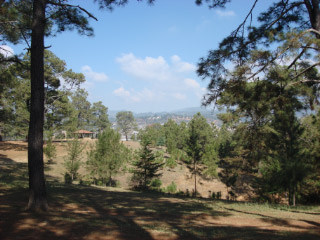 We drive to the top of the hill overlooking Tecámbaro and are impressed on
how nicely kept is this ecological park. A teacher is addressing a dozen school
girls under one of the shelters and a caretaker is working in another area.
Interestingly, all of the facilities are crafted to look like trees, even the
goal posts of a soccer field. Highlights of birding are Western Tanager,
Bullock’s Oriole
We drive to the top of the hill overlooking Tecámbaro and are impressed on
how nicely kept is this ecological park. A teacher is addressing a dozen school
girls under one of the shelters and a caretaker is working in another area.
Interestingly, all of the facilities are crafted to look like trees, even the
goal posts of a soccer field. Highlights of birding are Western Tanager,
Bullock’s Oriole , Greater Pewee and Black-headed Siskin. We are about to leave,
and half are already in the cars, when I recognize a Buff-breasted Flycatcher
which gets everyone back out to see the bird. On the drive out we stop once more
for a pair of White-breasted Nuthatches.
, Greater Pewee and Black-headed Siskin. We are about to leave,
and half are already in the cars, when I recognize a Buff-breasted Flycatcher
which gets everyone back out to see the bird. On the drive out we stop once more
for a pair of White-breasted Nuthatches.
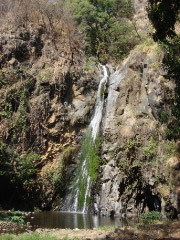 From the coolness of the mountaintop pine forest we descend to the dry hot
cane fields along a deep and narrow ravine cut by a Rio Corucha. We stop for
lunch, but soon leave because the sun is too hot and the birds absent. Instead,
Georgia leads us to a birding spot I didn’t know about, a few miles beyond
Chupio. Arroyo Frio is a splendidly wooded ravine sporting a tall waterfall
plunging from a rock cliff. The waterfall feeds a swimming pool which
undoubtedly would be filled on weekends with local residents from the ejido that
built and maintains this facility, but today is vacant except for caretakers
operating a concession stand. In the comfort of the tall shade trees and some
drinking cervesa while sitting on the chairs that surround the pool, we study
the birds around us. A Squirrel Cuckoo makes a frequent appearance and several
White-throated Thrushes feed in the canopy as a pair of Rufous-backed Thrushes
browse in the leaf litter. We hear a Canyon Wren and later see it in the rocky
parts of the canyon. We wanted to see Russet-crowned Motmot and Golden-cheeked
Woodpecker, but find neither today although Georgia tells us they are regular
residents.
From the coolness of the mountaintop pine forest we descend to the dry hot
cane fields along a deep and narrow ravine cut by a Rio Corucha. We stop for
lunch, but soon leave because the sun is too hot and the birds absent. Instead,
Georgia leads us to a birding spot I didn’t know about, a few miles beyond
Chupio. Arroyo Frio is a splendidly wooded ravine sporting a tall waterfall
plunging from a rock cliff. The waterfall feeds a swimming pool which
undoubtedly would be filled on weekends with local residents from the ejido that
built and maintains this facility, but today is vacant except for caretakers
operating a concession stand. In the comfort of the tall shade trees and some
drinking cervesa while sitting on the chairs that surround the pool, we study
the birds around us. A Squirrel Cuckoo makes a frequent appearance and several
White-throated Thrushes feed in the canopy as a pair of Rufous-backed Thrushes
browse in the leaf litter. We hear a Canyon Wren and later see it in the rocky
parts of the canyon. We wanted to see Russet-crowned Motmot and Golden-cheeked
Woodpecker, but find neither today although Georgia tells us they are regular
residents.
On the drive back to Pátzcuaro, we stop near 10,000-ft. elevation to see if
we can find Red Warbler in the pine forest. The forest is still and absent of
birds. We stop once more in open farmlands where we are surprised to see a flock
of hundreds of Brewer’s Blackbirds. At our 5 PM social back at camp, our bird
count off reaches 58 species, a number I consider very good for high elevation
birding.
(Shari) Bert is gone and, at 8:15, I am freezing. We try not to run our
heater to save on battery life but this is ridiculous. I get out of my warm
cocoon and attempt to start the generator. Nada! Ah, oh! While in Texas we spent
$350 getting it cleaned up (the carburetor got gunked up while in 8 months of
storage) and the generator still does not run smoothly. Is it gong to die on me
too? I look at the gauges and another dead battery. This happened while in San
Roberto but we thought it was because we left a heater switch on. No heater
switch on this time. Luckily I can start the RV engine and then use that battery
juice to start the generator. That is what I do and soon I am making a café
latte - the best present Bert ever gave me was that espresso maker - and running
the microwave and heater. At the decent hour of 10 AM, Marlene, Larry, Jane and
I get in the car to check out the timing of the boat to the island tomorrow. We
find the marina, learn that tickets are 40 pesos per person, and that the boat
leaves every 30 min. Unfortunately, the Dance of the Old Men now only happens on
Saturdays when we are not here, so we will miss that event. Our next stop is a
decent Sorianna, where we ponder the recipe for margaritas using real limes. I
buy 4, borrow Marlene’s blender to make a small batch of margaritas, and we
taste test as we play Sequence and later Phase 10. By the time the birders come
back we are a happy bunch of women. The whole group gathers to socialize
bringing their own drinks and snacks. I cannot keep up with all the
conversations going on around the circle of chairs. What a group we have! I love
it!
Day 10 – January 23 – Cerro Burro, Lago de Pátzcuaro and Janitzio, Michoacán
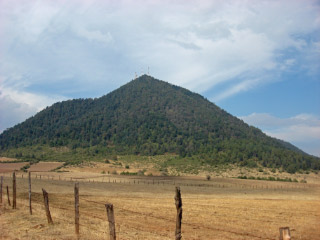
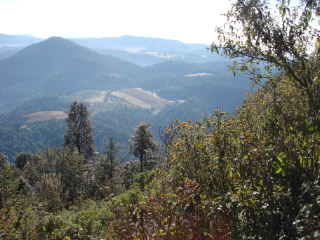
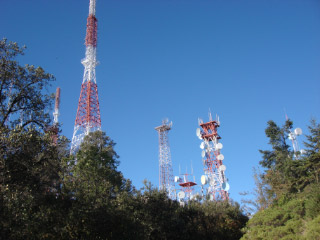
(Bert) Georgia again leads us to a new birding spot, one I’ve passed on the
Pátzcuaro – Tecámbaro highway but not stopped. At the sign for Cerro Burro we
turn on to a very uneven rock road which leads past cornfields and pastureland
to the base of a steep and rounded mountain with radio towers on top. Our SUV’s
lumber up the steep road for almost 4 mi., although it feels more like 40. We
stop when we reach the radio towers and step out into the chill of the early
morning at 10,796 ft. elevation. Birds are reticent to show themselves, but not
the bees and other insects. Flowers abound: blue lupines, orange paintbrushes,
bushy yellow flowers and huge pink bull thistle flowers. Thousands of bumblebees
and colorful moth-like insects with swept back wings like a fighter jet feed on
the flowers.
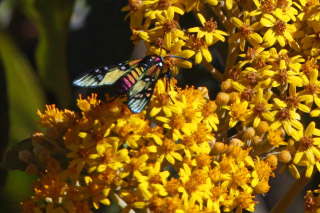
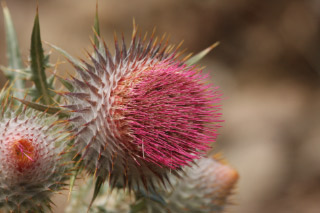
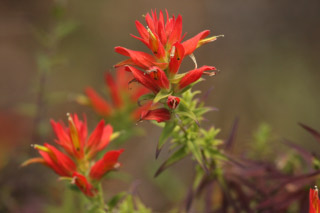
On a sad note, we see many splendid trees being removed from the primary
forest and can hear a chain-saw buzzing throughout the day. Without erection of
the radio towers and construction of the steep mountain road that connects to
the facilities, access to this forest was too difficult, so only the flat
farmlands below were cleared. Now access is easy and, although prohibited, local
people come in to steal the trees. Sadly still, the prime lumber is sawed into
short chunks for the fireplaces of the gringos that have moved into the area and
built homes in this pleasant climate. So, for the pleasure of a fireplace, the
few remaining primary forests are being cut, adding to our carbon imbalance,
eroding hillsides and removing habitat for birds that have few other choice
areas to live and reproduce.
We don’t see a lot of birds today, but the list includes many special ones.
Gray-barred Wren is our first, seen quickly and later heard chattering elsewhere
in the forest. We soon have an empid challenge and fortunately this one stays
perched long enough to get good photos and to hear it sing a complicated song. I
suggest Hammond’s Flycatcher and others eventually agree.
 Later I see two other empids repeating the same tail flicking behavior just after finding a new perch.
Hummingbirds are frequently seen, mostly White-eared and Broad-tailed, but also
Rufous and Magnificent, the latter singing an oft-repeated quick 3-note chirp.
Later I see two other empids repeating the same tail flicking behavior just after finding a new perch.
Hummingbirds are frequently seen, mostly White-eared and Broad-tailed, but also
Rufous and Magnificent, the latter singing an oft-repeated quick 3-note chirp.
Too far away to see, a Brown-backed Solitaire sings its song that I associate
with a descending waterfall of tinkling broken glass fragments. We work our way
down the mountain, pulling our cars off the 2-track just far enough to avoid
falling off the cliff on one side and scraping against any vehicle coming past
us on the other. A couple of ravens fly over, issuing a duck-like call that I
always associate with Chihuahuan Raven, as do two others in our group, but
Georgia thinks only Common Raven is in this range. Howell states we are at the
southern edge of its range.
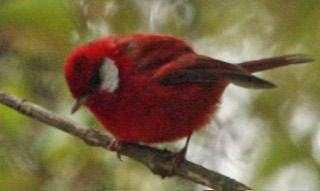 One of our sought after birds is Red Warbler and we get frequent, if brief,
looks at these bright red birds with white ear patches. Another warbler, rarer
and a life bird for some, is Golden-browed Warbler. Tom and I get good views of
one, including at 6 ft. range.
One of our sought after birds is Red Warbler and we get frequent, if brief,
looks at these bright red birds with white ear patches. Another warbler, rarer
and a life bird for some, is Golden-browed Warbler. Tom and I get good views of
one, including at 6 ft. range.
Perhaps the most unusual bird of the day is a hybrid, a cross between quite
different looking species: Collared Towhee and Rufous-sided Towhee. Not
illustrated in Howell and Webb’s book, but described there, what we see is a
green back and tail, whitish undersides absent of rufous, a dark head that
sometimes sports a rufous crown. I wish I could have photographed one, but all
our looks are brief as this species loves to stay hidden in brush piles and
thick undergrowth. Two other great finds of the afternoon are a Rufous-capped
Brushfinch and, for Tom and Maxine only, a Green-striped Brushfinch. A great
birding day in the high mountains, we are especially grateful to Georgia for
showing us around her birding areas. Georgia’s name should be familiar to
subscribers to the Mexbirds e-group; if not, you can look her up on her
blog.
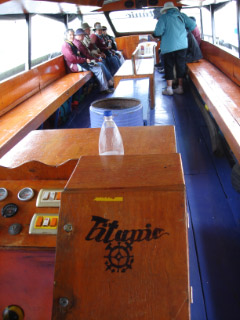 (Shari) Contracts mean little in Mexico. I have learned that and do not get
as upset as I used to. It is not a matter of totaling the number of rigs and
multiplying times the cost per night as stated on the contract. You can bet it
will be more. Just how much more depends on your ability to barter. Today is no
different. You would think that the park would be happy we squeezed ourselves in
without facilities. No, they not only want full price but a price higher than my
December 8 contract. I ask Roman, the manager, to call the owner. He holds fast
on the higher price but I negotiate the two nights without hookups at the lower
price. Two of our rigs had electricity and I must pay full for them. I say one
has only one person. Finally we settle on a price we both can live with, but I
hold a grudge. If there was an alternative I would take it. No competition here
is the problem. So after my money exchange I get all flustered and forget to
take binocs, hat and sunglasses on our boat outing to the island of Janitzio.
Fortunately, Charlu loaned me sunglasses and I bought a cute sun visor made from
straw for only $1.50.
(Shari) Contracts mean little in Mexico. I have learned that and do not get
as upset as I used to. It is not a matter of totaling the number of rigs and
multiplying times the cost per night as stated on the contract. You can bet it
will be more. Just how much more depends on your ability to barter. Today is no
different. You would think that the park would be happy we squeezed ourselves in
without facilities. No, they not only want full price but a price higher than my
December 8 contract. I ask Roman, the manager, to call the owner. He holds fast
on the higher price but I negotiate the two nights without hookups at the lower
price. Two of our rigs had electricity and I must pay full for them. I say one
has only one person. Finally we settle on a price we both can live with, but I
hold a grudge. If there was an alternative I would take it. No competition here
is the problem. So after my money exchange I get all flustered and forget to
take binocs, hat and sunglasses on our boat outing to the island of Janitzio.
Fortunately, Charlu loaned me sunglasses and I bought a cute sun visor made from
straw for only $1.50.
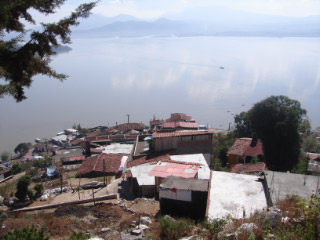 We board the Titanic in the fog; it does not go unnoticed by the group. Just
as we dock the fog dissipates and we have a gorgeous day to shop, climb the hill
to the statue and eat lunch. The picture that stays with me depicts a bit of
Mexico. As I am walking down the hundreds of uneven steps toward the dock, I see
a wheelchair. Down a bunch of steps is an old woman, seemingly blind and 100
years old, helped by a younger woman. They walk painstakingly slowly towards
that wheelchair and the younger woman has so much patience. “Necisita ayudar?” -
Do you need help - I ask. She smiles and looks up at me and says “No, gracias”.
I wonder where these two live, why they were climbing that hill and what is
their relationship. We in the U.S. seem to put our elderly in nursing homes. I
am no exception and think of my father. I am sad. On a happier note, at the
restaurant, I cannot decide whether to order my favorite whole fried fish or
chili relleno. They make the best rellenos here. I decide to order the fish and
get rellenos at the dock. You snooze you loose, so the saying goes. I try to buy
rellenos but the girl delays so long in packing them up that I tell her I must
leave. I have riders waiting for me. Betty and Jim take the prize for shopping.
Two big hats, T-shirts, etc., are in at least two bags that I see. I buy a beer
mug depicting “the dance of the old men”. I try to buy the rellenos at the
grocery store but no luck. I must have bemoaned the fact so much and sounded so
disappointed that Heather asks us to join her and Bob for dinner. Yum!
We board the Titanic in the fog; it does not go unnoticed by the group. Just
as we dock the fog dissipates and we have a gorgeous day to shop, climb the hill
to the statue and eat lunch. The picture that stays with me depicts a bit of
Mexico. As I am walking down the hundreds of uneven steps toward the dock, I see
a wheelchair. Down a bunch of steps is an old woman, seemingly blind and 100
years old, helped by a younger woman. They walk painstakingly slowly towards
that wheelchair and the younger woman has so much patience. “Necisita ayudar?” -
Do you need help - I ask. She smiles and looks up at me and says “No, gracias”.
I wonder where these two live, why they were climbing that hill and what is
their relationship. We in the U.S. seem to put our elderly in nursing homes. I
am no exception and think of my father. I am sad. On a happier note, at the
restaurant, I cannot decide whether to order my favorite whole fried fish or
chili relleno. They make the best rellenos here. I decide to order the fish and
get rellenos at the dock. You snooze you loose, so the saying goes. I try to buy
rellenos but the girl delays so long in packing them up that I tell her I must
leave. I have riders waiting for me. Betty and Jim take the prize for shopping.
Two big hats, T-shirts, etc., are in at least two bags that I see. I buy a beer
mug depicting “the dance of the old men”. I try to buy the rellenos at the
grocery store but no luck. I must have bemoaned the fact so much and sounded so
disappointed that Heather asks us to join her and Bob for dinner. Yum!
Day 11 – January 24 – Zitácuaro, Michoacán
(Bert) Again we circle on the periferico around Morelia, this time on the
south side. I’d hate to imagine what it would be like to take RV’s through the
center of this large city; the circle route is rather easy, although frequently
interrupted by stoplights. Shari suggests that the traffic might be lighter on
this Saturday morning, but it is not. Just as we are about to exit the city,
heading eastward, we encounter a construction zone which really snarls traffic.
For at least 20 min. a hundred cars are nearly at a standstill: four lanes
narrowing into two, an additional two side streets pouring into the same
intersection and traffic lights that infrequently turn green because of heavy
cross traffic. Eventually we untangle ourselves and are on the open road through
pretty countryside of pastureland, cornfields and grain fields. We pass through
small villages, slowed by topes on each end. One village has a narrow one-way
street and we are almost within hand reach of the dozens of small shops
displaying their wares outside the storefronts on tiered shelves. The fresh
bakery is especially tempting. The rolling countryside turns upward and steep as
we serpentine through the volcanic mountains. At one point I count the curves
and calculate we are turning 6 times per mile, sometimes on 180º hairpin turns.
At slow pace, though, the driving is easy and we have time to enjoy the pretty
scenes, especially when we pass through Parque National Cerro de Cuernica. We
climb to 8000 ft. and then descent a bit to a Pemex station for our lunch break.
As usual, I jump out of the RV with binoculars in hand and check for birds. I
quickly return to retrieve my camera and then photograph Stripe-headed Sparrows
 and Spotted Wrens
and Spotted Wrens . Heather joins me, carrying her lunch with her, and we find
Western Bluebirds. Curiously, farther west we had Eastern Bluebirds and now
traveling east we find Western Bluebirds.
. Heather joins me, carrying her lunch with her, and we find
Western Bluebirds. Curiously, farther west we had Eastern Bluebirds and now
traveling east we find Western Bluebirds.
Back on the highway we continue through the mountains, bypass Ciudad Hidalgo
lying in a valley below us, and in short time are at the Pemex station where the
group will stage while Larry, Marlene, Shari and I take our vehicles ahead to
the campsite, a vacant lot beside a nice hotel. The group follows 20 min. later
and we are ready, dressed in orange vests and hats, with Larry blocking traffic
from one direction, me blocking it in the other, Marlene standing next to the
low stucco wall that is invisible to drivers making right hand turns and Shari
at the end of the driveway to direct vehicles to parking spots. To the chorus of
dozens of honking horns we get everyone safely inside the walled compound. Our
string of vehicles moves as quickly and safely as possible, yet the backed up
traffic probably stretches for nearly a mile. After a leisurely mid afternoon of
birding around the hotel, resting in the shade or doing household errands, we
gather at 5 PM where I have short presentations on Mexico geography and Birding
202. Then Shari tells us about our plans for tomorrow’s outing to the Monarch
butterfly reserve.
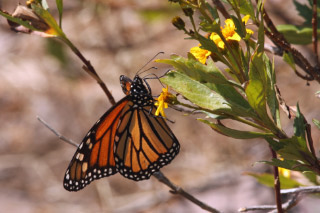
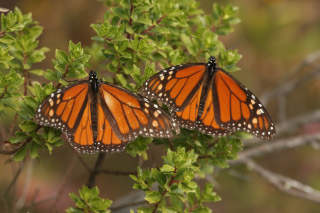
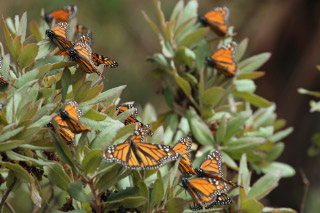
Day 12 – January 25 – Angangueo, Michoacán
(Bert) The elevation display on the GPS we use in our SUV shows we were
steadily climbing as does our inclination on the steep road and that the engine
is working hard to maintain a slow speed. The display reverts to all dashes when
we cross 10000 ft. – too many digits. After an hour’s travel we reach the dusty
parking lot of Sierra Chincua Biosphere Reserve, measured from another GPS at
10,680 ft. Yet we are still not done climbing. Some mount horses now, while the
rest hike through the forest. On one of our many stops to rest, Ken announces
his GPS reads just over 11,000 ft. Along the trail, which starts out nicely
groomed, we see information signposts and I glean enough of the Spanish to learn
the Monarchs (Danaus plexippus) migrant 4500 km from the U.S. and Canada
to these high mountains (2400-3600 m) in Central Mexico, traveling 75 km each
day (and up to 130 km), using the wind currents to aid their flight. The
Monarchs spend November to March here and we are hiking to the spot where they
have clustered on the fir trees for the night, a location that varies from year
to year. I look for a signpost that identifies the trees and find one that calls
them bosque de oyamel (Abies religiosa). We hike for nearly two and a
half hours - longer and farther than other years - and the path deteriorates to
a steep and rocky downhill trek between the trees. Shari is taking it at a
slower pace and I am impressed that she eventually completes the hike. We reach
the spot around noon and stand on a cliff overlooking fir trees below, some with
branches covered in thousands of slumbering Monarchs. Those that arrived much
earlier on horseback saw many more butterflies at rest, but now with the warming
sun, we are seeing them wake up and fill the sky with fluttering wings. Feeding
on yellow flowers, resting on pines and cactus, dancing before our eyes in
convoluted aerial patterns, the butterflies are magical eye candy. I use my long
lens camera to get close up views, my other camera for wide views and I record
video to capture the dance of wings, but I doubt these reproductions will equate
to the real thing.
(Shari) Everyone wonders how 21 mi. can take almost two hours to drive. I
remember the road to the butterfly preserve all too well; steep and full of
potholes, congested towns with narrow streets and many topes. This year we can
eliminate the potholes as the road seems newly paved with fewer topes, so we cut
30 min. from our time. We arrive at the parking lot and are accosted by children
hanging onto our car door handles trying to help us park in the obvious places.
While the group gets their stuff ready and finds the bathroom, I walk to the
ticket window and ask the price to enter the preserve. It is 30 pesos per person
and does not include horses. That is an extra 75 pesos one way. Last night I
told the group about the options: to walk or to ride. About half choose to walk
and the other half choose to ride. Last time the horse hurt so much that I am
among the walkers. I learn that the horse ride is 50 min. and the walk an hour.
I should have suspected something right then as the times are longer than in
2005. Then the ride was 30 minutes and the walk 45. After everyone is settled, I
follow the guide who takes the walkers. Dee and Milo are with me and I soon
realize this is tougher than last time. I was younger then and in better shape.
We walk up the first incline - we are over 10,000 ft. elevation - and need to
rest on the benches set out. Bert catches up as he was attending to Pat and her
dog Brutus who decides to take a horse up and carry the dog. I tell him to go on
ahead and that I do not think I can make it.
After resting we climb the next hill and again rest on benches. I notice a
sign that says the butterflies are still 3 km distant. After resting, I leave
Milo and Dee and climb alone resting on my 3-legged stool as needed. Soon the
terrain levels out and I can go at a pretty good clip. Maybe I can make this
after all. Then the path takes a sharp down hill turn. I walk a long while and
ask some people coming back how far? They tell me another 30 min. I have been
walking for 90 min. so far and should not quit now. I keep going down. My legs
hurt, the path is no longer smooth but rocky, I sit on my stool and try to reach
Bert on the radio. Surprisingly, he answers and we determine I am only 10 min.
behind him. I walk some more. The path becomes more steep and rocky. I sit and
call Bert again. He suggests I take the path the horses take but since there are
no horses to follow, I decide to continue on the main path. A guide with a group
of people passes me as I sit on my stool. They smile and we all agree we are
tired. I talk to Bert and wonder if I can make this. I decide I had better
follow the guide as he veers off the main path and takes a narrow one which
seems a little easier, for a bit anyway. It gets tough and one of the men slows
down to help me over a stump and then some barbwire. I don’t think I can make
this. Onward. I finally see the horses and know I can make it. I plop myself on
the stool to rest. I have been walking for 2.5 hours and I still am not at the
butterflies. I call Bert on the radio and he says I have another 5 min. to walk.
Oh gees! I don’t know if I want to see these butterflies anymore. Bert walks
back to help me, carries my stool and I slowly make my way down the slope. He
unfolds my stool and I sit on the bluff overlooking the trees and see a
gazillion monarch butterflies fluttering in the sun. It is a sight to behold. We
marvel for a good while and then it is time to return. I know I will not make it
up those steep hills, a distance I later learn is 2.6 mi. one way. I hardly make
it to the horses and I rest on my stool.
Bert had not carried any snack or water so I share some trail mix with him
and half my water. Many young men are asking us if we want a horse to return. Oh
my, do I! I pick out a horse I think will be most comfortable and motion to a
stump that I can climb onto so I can get over the saddle. I hope no one takes
any pictures of this. I am on the horse and it is not too bad. Off we go.
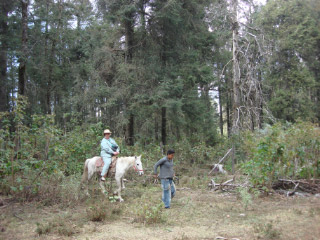 (Bert) Shari is exhausted when I find her sitting on a three-legged stool
where the horses are gathered. I lead her to where I had been watching the
butterflies and enjoy them a second time. Others have begun the hike or ride
back and only Tom and Charlu are still here when Shari selects a horse to ride
back. She is very particular since she wants a thin horse which she thinks will
be easier to ride. As we move through the herd, dozens of Mexican boys each
encourage me to select their horse, speaking only Spanish except for the word
“horse”. When one of them attracts my attention by saying “Meester” I look at
his fine black horse and choose his. The other boys laugh and repeat the word,
sure now that is the reason I picked his. On the ride back, which progresses at
nearly three times the speed we walked earlier, the horse attendant leads or
follows, holding the reins. The horse breathes heavily, but the boy does not.
(Bert) Shari is exhausted when I find her sitting on a three-legged stool
where the horses are gathered. I lead her to where I had been watching the
butterflies and enjoy them a second time. Others have begun the hike or ride
back and only Tom and Charlu are still here when Shari selects a horse to ride
back. She is very particular since she wants a thin horse which she thinks will
be easier to ride. As we move through the herd, dozens of Mexican boys each
encourage me to select their horse, speaking only Spanish except for the word
“horse”. When one of them attracts my attention by saying “Meester” I look at
his fine black horse and choose his. The other boys laugh and repeat the word,
sure now that is the reason I picked his. On the ride back, which progresses at
nearly three times the speed we walked earlier, the horse attendant leads or
follows, holding the reins. The horse breathes heavily, but the boy does not.
When we get back to the parked cars, many have already headed to camp. While
munching on a sandwich I find a Brown-throated Wren in the bushes. Bob, Heather,
Tom, Charlu and I stay longer to bird the forest edge. Earlier during our hike I
had seen Pygmy Nuthatch, Townsend’s Warbler and Red Warbler. Bob and Heather
want especially to see the Red Warbler and we soon find one, as well as
Yellow-eyed Juncos, Mexican Chickadee and a Golden-crowned Kinglet tilting its
head to display its kingly crown.
(Shari) My horse is Palomino and my guide Miguel has to slap him on the rump
to get him to move up the steep incline. We follow Bert and his guide up, up,
up. It is uncomfortable, but way better than walking. Sometimes the horse goes
too fast and I say, “Despachio por favor“ - slow please. Miquel says “Propina”.
At this point he can ask for anything and I’ll gladly give him his tip. We trot
on for 30 min. uphill and then the descent. Going downhill on a horse with a
wooden saddle is no picnic. I yell I want to stop and get off. Bert gets off
first and then he helps me. I fall right into him and I am so stiff I can hardly
walk. Miguel indicates by pointing that we must walk straight ahead and about 30
min. Okay, I know I can make it. I take my time and enjoy the pine smell unless
it is mixes with horse manure. Finally I hear the horse lot and then see it. I
am almost home free. I collapse at the car, grateful that Tom and Charlu and
Jill and Mike are not back yet. We eat our lunch and I nap in the car. I hear
that everyone really enjoyed their outing and the butterflies. I just think I
bit off more than I could chew after being sick with heart issues this fall.
I am totally exhausted and sure am not cooking dinner tonight. We stop on the
road to pick up pollo lena - grilled chicken over wood - including rice, beans,
vegetables, salsa and tortillas. The group gathers before dinner, relating their
experiences. Valerie says it was the best day this trip and that every day was a
great day. Betty is so proud of the fact that she road the horse there and back.
Janice and Jane are proud too that they made the walk and road the horse back.
Everyone agreed that they had never seen so many butterflies, even in
California. It was a fun day.
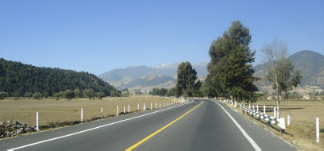
Day 13 – January 26 – Cuernavaca, Morelos
(Shari) A sign indicating a cuota road to Toluca greets us early this
morning. I tell Bert to take it. The road is so new that it is not even in the
2008-09 Mexico Atlas, but it cuts off miles of steep ascents and descents and
dangerous curves. Bert and I have a discussion on when to get off. I want to get
off before Toluca because we do not know where in Toluca this will take us. Bert
wants to continue. I say, “Okay, fine. I want to go on the record that I
disagree.” Who do you think won? Bert turns off and I find where on our road log
we are. At least, I think I do. I never see the mentioned Deportiva at mile mark
60.4 but do see the Wal-Mart at mile mark 60.7. The map of Toluca indicates a
new ring road and I had mentioned at travel meeting this morning that we were
going to take it. We find it right after the Wal-Mart. We keep following signs
to Metepec and Taxco discussing at one point whether to go right or left. We go
left and we are correct. Traffic is horrendous, but the group stays together
quite well and communicates through CB relay. Continue straight; turn right;
follow signs; stay right, etc.; so the road log goes for over 10 mi. Finally we
are out of the city and on our way to Taxco.
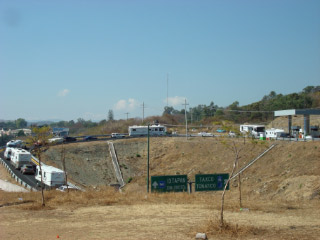 The cuota road to Taxco comes up sooner than I anticipate but we do NOT miss
it. Bert wants to stay on the cuota road longer than I do. I again tell him that
we do not know where it drops us off and we are exiting the cuota at a town I
recognize. We are back on the log clicking off points as the miles go by. We
come to a turn to Cuernavaca that does not seem right. It is too soon to show up
but then again it is not mentioned on our log. We have the choice of going to
Taxco or to Cuernavaca. We take the turn to Cuernavaca and then decide we are
wrong. Luckily only one other RV made the turn. All we have to do is make a
U-turn which Bert does easily, as does Gordon. Thank goodness for our small rig.
We recover and head to Taxco. It takes me 10 mi. to realize that we are not on
the road log yet again. No place to turn a caravan around on the steep winding
road to Taxco. For the next 30 mi. we are blazing a new trail again. I keep
wondering if this will put us on the cuota road to Cuernavaca. You can imagine
my relief when it does. Finally we are back on the log and heading down the
narrow gravel road through the field to our campground. Boy, do margaritas taste
good tonight!
The cuota road to Taxco comes up sooner than I anticipate but we do NOT miss
it. Bert wants to stay on the cuota road longer than I do. I again tell him that
we do not know where it drops us off and we are exiting the cuota at a town I
recognize. We are back on the log clicking off points as the miles go by. We
come to a turn to Cuernavaca that does not seem right. It is too soon to show up
but then again it is not mentioned on our log. We have the choice of going to
Taxco or to Cuernavaca. We take the turn to Cuernavaca and then decide we are
wrong. Luckily only one other RV made the turn. All we have to do is make a
U-turn which Bert does easily, as does Gordon. Thank goodness for our small rig.
We recover and head to Taxco. It takes me 10 mi. to realize that we are not on
the road log yet again. No place to turn a caravan around on the steep winding
road to Taxco. For the next 30 mi. we are blazing a new trail again. I keep
wondering if this will put us on the cuota road to Cuernavaca. You can imagine
my relief when it does. Finally we are back on the log and heading down the
narrow gravel road through the field to our campground. Boy, do margaritas taste
good tonight!
(Bert) A day in the mountains, we start out at about 6200 ft. and soon after
Zitácuaro we find a new toll road that quickly takes us to 9402 ft. surrounded
by pine forest. I alternate between first and second gear for braking action as
we partially descend on the other side. Most of the morning we wind left and
right, up and down, at about 9000 ft. plus/minus 500 ft. We find more new cuota
roads, not shown on our new maps, but we do not find a better route that takes
around the south side of Toluca and we enter the same vehicle-jammed streets
we’ve taken other years (although Shari thinks it is different). When we finally
withdraw from the clutches of Toluca we have the fourth highest mountain in
Mexico in our sights: 15,387-ft. snow-covered Nevado de Toluca. Not a clear
view, the mountain is surrounded by erasure marks of clouds probably filled with
the same smog that permeates congested Toluca and nearby Mexico City. We head
south, still through mountains, heading toward Taxco. I remember this
fascinating scenery, aridly brown in winter, but cannot recall exactly how I
described it four years ago. Later I look up the description: “They are sleeping
giants clothed in ragged brown burlap. Up and down, we curve around the rounded
buttocks, shoulders and feet of the giants.”
The narrow mountain road lacks pullouts large enough for 12 rigs but as we
enter Tonatico the street splits into a boulevard with an extra lane, so we park
there for lunch. As usual, I grab my binoculars and look for birds while Shari
makes sandwiches. Uniformed girls, perhaps 10 or 11 years old, are playing
soccer and while I watch, the game ends and the victorious team links arms,
shoulder to shoulder, and dances and shouts in cheer. Above me I notice a
circling hawk, riding the thermals of high noon. It is a dark morph Short-tailed
Hawk soon joined by another. I tell Tom about it, the only person not inside
their RV eating lunch, and by the time Heather comes out with binoculars the
hawks are gone.
We are descending now by thousands of feet and just when I think we must be
done going downhill, we go back up again, so steeply I wonder if R-Pup-Tent’s
engine will overheat, but it doesn’t. We find another new toll road and
eventually connect to the well-known Cuernavaca-Acapulco cuota road. From there
it isn’t far to our campground south of the city. Margaritas around the pool,
under the shade, with a boisterous chorus of Social Flycatchers in the trees
above us, is a fitting end to a long day for moving just 175 mi.
Day 14 – January 27 – Coajomulco, Morelos
(Bert) With the millions of people we pass by, from a freeway clogged with
thousands of cars and trucks, it surprises me that just beyond the city limits
of Cuernavaca we can find a place as peaceful and bird-filled as Coajomulco.
Mexico City bound traffic still whizzes by on each side of the wooded oasis and
a few people live in ramshackle houses on the opposite side of the highway, but
the trees and underbrush muffle the noise of tires and we can easily hear the
birds. Except for a once-planted field that has converted to grass and stubble,
nothing has changed about this place since I first visited six years ago.
I am distracted from the main path by a calling Olive-backed Towhee
 – a
Rufous-sided Towhee with a green back that looks different than either Eastern
or Spotted – and while standing on a bare hillside overlooking a wooded area we
are entertained with a 3-ring circus of active birds, including White-eared
Hummingbird, Acorn Woodpecker, Hairy Woodpecker, Brown-backed Solitaire (heard)
and Townsend’s Warbler. Turning uphill I photograph a patient Greater Pewee
– a
Rufous-sided Towhee with a green back that looks different than either Eastern
or Spotted – and while standing on a bare hillside overlooking a wooded area we
are entertained with a 3-ring circus of active birds, including White-eared
Hummingbird, Acorn Woodpecker, Hairy Woodpecker, Brown-backed Solitaire (heard)
and Townsend’s Warbler. Turning uphill I photograph a patient Greater Pewee
 and
we see our first Rose-throated Becard of the trip. A noisy and conspicuous
species that clowns around in the low branches, especially at forks clogged with
bromeliads is the Gray-barred Wren
and
we see our first Rose-throated Becard of the trip. A noisy and conspicuous
species that clowns around in the low branches, especially at forks clogged with
bromeliads is the Gray-barred Wren 

 and we find them repeatedly all day. Another
common bird, yet with a totally different personality, is the Russet
Nightingale-Thrush
and we find them repeatedly all day. Another
common bird, yet with a totally different personality, is the Russet
Nightingale-Thrush . This one avoids being seen, sticks to the ground under
deeply shaded brush. I see it often enough to differentiate it from the two
other Nightingale-Thrushes that occur here, although not seen today. Another skulker that surprisingly we find at three locations is Blue Mockingbird. Janice
adds Gray Silky-flycatcher to the list, although none of the rest of us find one
in an area I thought they would be common. Warblers are in nice variety – nine
species - in the morning and a few are special ones most of us don’t often see:
Olive Warbler, Crescent-chested Warbler, Hermit Warbler and, again, Red Warbler.
. This one avoids being seen, sticks to the ground under
deeply shaded brush. I see it often enough to differentiate it from the two
other Nightingale-Thrushes that occur here, although not seen today. Another skulker that surprisingly we find at three locations is Blue Mockingbird. Janice
adds Gray Silky-flycatcher to the list, although none of the rest of us find one
in an area I thought they would be common. Warblers are in nice variety – nine
species - in the morning and a few are special ones most of us don’t often see:
Olive Warbler, Crescent-chested Warbler, Hermit Warbler and, again, Red Warbler.
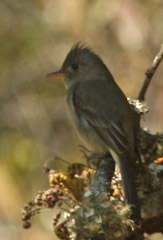 In my mind, the best finds are the flycatchers, not because they are the
prettiest but because they are the most challenging. In fact, to the novice eye
they all look identical. The subtleties are the slight differences in overall
coloring - from grayish to brownish to yellowish to greenish – the bill color,
the absence or presence of a crest and a few other easily overlooked
differences. Our flycatcher prizes today are Pileated
In my mind, the best finds are the flycatchers, not because they are the
prettiest but because they are the most challenging. In fact, to the novice eye
they all look identical. The subtleties are the slight differences in overall
coloring - from grayish to brownish to yellowish to greenish – the bill color,
the absence or presence of a crest and a few other easily overlooked
differences. Our flycatcher prizes today are Pileated , Tufted and Pine
, Tufted and Pine , all
three of which I photograph. Pileated Flycatcher is the first life bird of the
trip for Gordon and Maxine, whose list numbers above 5000 species.
, all
three of which I photograph. Pileated Flycatcher is the first life bird of the
trip for Gordon and Maxine, whose list numbers above 5000 species.
We bird until almost 2 PM and are wearily climbing uphill, pausing to rest,
when Tom is prowling around the bushes as usual. This time at the edge and in
good sunlight he shows us several birds feeding on the ground and low bushes and
for 15 min. we get good views of the odd towhee, another Russet
Nightingale-Thrush and a female Cinnamon-bellied Flowerpiercer . Opposite the
field, Maxine finds the Brown Creeper that a few others had found earlier. We
end our birding with a good list of 47 birds, gathered in very pleasant
surroundings.
. Opposite the
field, Maxine finds the Brown Creeper that a few others had found earlier. We
end our birding with a good list of 47 birds, gathered in very pleasant
surroundings.
(Shari) Riding with Larry and Marlene, our first stop is the lavanderia.
Eight pesos per kilo is the price for the lady to wash and dry our dirty
clothes. My 15 lb. bag comes to 56 pesos or less than $4.00. We hope we
understood all the Spanish. Is she going to wash and dry the clothes and is it
today or tomorrow at 7:30 that they will be ready?
Next it is off to Wal-Mart. The streets are much more crowded than I
remember. We shop for our Mexican hotdog dinner tonight buying beans, chips,
tortillas and more tequila and orange liquor for future margaritas. A pound of
tomatoes is 23 cents and 2 lbs. of broccoli is 60 cents. Jane notices the price
disparity between here and the U.S. saying she paid a little over $20 for what
would have cost $100 in Spokane. It is noon and Marlene and I want to find a
restaurant, but Larry has his mind set on finding the Dodge dealer for Paul, who
has a “check engine” light illuminated on his truck. We wander around Cuernavaca
centro for what seems like hours. I feel like we are totally lost and, hungry, I
eat a cookie from my grocery bag. I think Marlene still hopes to find a
restaurant. Wonder of all wonders, in front of us is the toll road to Acapulco:
just the road we were looking for. I say it is a miracle. Larry says he knew
where he was going all along. We find the Dodge dealer, Larry makes a 9 AM
appointment for Paul tomorrow and we head to the laundry. Our clothes are half
done. We return to camp and I make salsa for this evening and take a nap until
Bert comes home. The Mexican hot dog supper is a whopping success even though it
starts late due to the sighting of a Colima Pygmy-Owl  that every birder wants to
see. Gordon compliments me on the dinner and I am amazed that he is so
appreciative to have to cook lowly hot dogs by himself. This group is just too
easy.
that every birder wants to
see. Gordon compliments me on the dinner and I am amazed that he is so
appreciative to have to cook lowly hot dogs by himself. This group is just too
easy.
Day 15 – January 28 – Atlacholoya and Taxco, Morelos
(Bert) Some days I really feel like a birding guide and on others I’m just
spinning my wheels. When we visit what I think is a good site and I know I’ve
seen good birds there and the habitat is right and the time of day is right, but
everything is dead quiet, not a bird singing, not a sparrow scratching in the
leaves, not a quick flight or branch bending or leaf turning to indicate any
birdlife, I feel I’m not much of a guide. However, on mornings like today, I’m
the expert guide who knows where to find the birds.
Gordon tells me, as we are leaving at 7:30 AM, that he looked at the local
list of birds and three, and only three, on the list would be lifers for him and
Maxine: Banded Quail, Black-chested Sparrow and Dusky Hummingbird. We park the
car and I say, “Let’s go for the quail first”. We are distracted with so many
other birds along the farm road that it’s a half-hour before we get to the quail
spot. I tell the group that the quail are in the tall weeds and brush along the
creek adjoining the farmlands. When we are 50 ft. away I see one and quickly
point it out to the others. Several Banded Quail cross our path and we have a
good full-length view of the bands and top crown. One down, two to go!
We walk back to our cars and drop off our jackets as the bright sun has
warmed the air. Then I tell Gordon and Maxine that we can find the sparrow on
the brushy thorn forest on the hillside where we are parked. We walk the paths
cut through by cattle and within minutes I spot the first Black-chested Sparrow
 in the brush behind a Prickly Pear cactus. That one flies away but in a short
time we find several more of these very attractive and large sparrows. Two down,
one to go!
in the brush behind a Prickly Pear cactus. That one flies away but in a short
time we find several more of these very attractive and large sparrows. Two down,
one to go!
The hummingbird is a bit harder to track down. I say to the birders, it could
be anywhere in this open habitat. Coincidentally, within minutes I see one
perched and quickly point it out to the others. Three down, none to go! Mission
accomplished! Three lifers for Gordon and Maxine and the same three for Milo,
Jim and Betty.
(Shari) My intention was to get to Taxco before the crowds. For numerous
reasons the eight of us in two cars got started 20 min. late. Then John’s car is
stopped by the military for a thorough check. I keep looking at my watch as the
minutes tick off. At one point I wonder if we are on the right road or have
missed our turn since it seems we have been climbing so long into nothingness.
Finally we get to Taxco, now snarled in traffic. Plan B. Let’s find a parking
garage, park the cars and take a taxi to the zocolo (city square). Easier said
than done! We crawl at snail’s pace up the narrow street. Finally I see a big
“E” denoting parking 100 meters to the right. I say let’s take it. Small vans,
taxis, cars and trucks share the very narrow street with market stalls, goods,
vendors and pedestrian shoppers. We inch our way up trying not to hit anything.
After the fact, I hear that John was a bit nervous. Bob handled the car like a
pro and soon we cover the 100 meters, turn left and get out of the car with a
sigh. We don’t know where we are, but at this point don’t care either. I ask for
a map and am surprised that I get one and even more surprised that it shows
where we are in relation to where we want to be. I am told the square is about a
20 min. walk up, to the left and then right. We walk, the street ends in a
market full of hundreds of vendors selling hundreds of stuff. We pass through
the fruit area, the clothes area and the flower area. We dead end and I ask for
directions again. I find it very interesting to see all this stuff. Finally we
arrive at the place I wanted and agree to meet in 45 min. for lunch. Everyone
scatters to peruse one silver shop after another. I wonder how anyone can make a
living selling all these silver chains, necklaces, earrings, bracelets, etc. It
all looks the same.
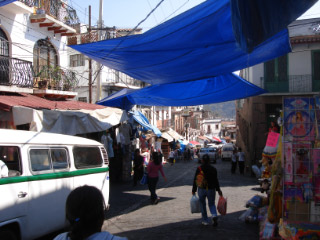
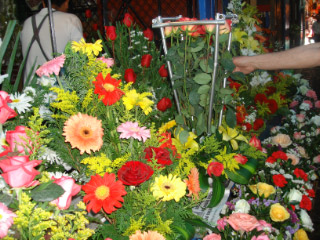
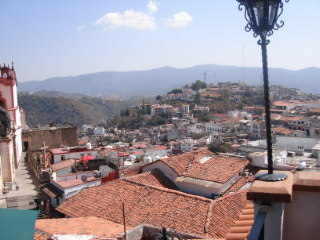
We find a wonderful restaurant on top of a hotel where we sit under umbrellas
enjoying the breeze and bird’s eye view of the town. Bob gives two musicians ten
pesos to sing and play “Perfidio”. While they sing, he and Janice dance in an
area of 3 sq. ft. Some are not done shopping and we agree to meet again at 3:50.
Trying to gather eight people is like herding chickens. One wants to get one
more thing. Okay, we have seven people. Well, while the one is off getting the
last thing, another, not wanting to wait, takes off in a different direction.
Then the first one comes back and now we have to wait for the third. Then
another two depart. What a mess! Finally we get back to the cars and drive home.
It was a fun day in a fun town and we gather for social hour with all our chairs
in a single line. We talk about our day as we watch birds come home to rest in
the trees for the night.
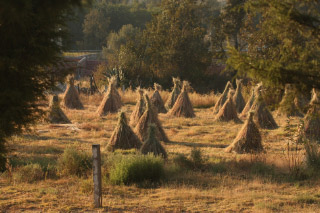 Day 16 – January 29 – Huitzilac and Lerma marshes, D.F.
Day 16 – January 29 – Huitzilac and Lerma marshes, D.F.
(Bert) By 7:50 we are high above Cuernavaca and just beyond the village of
Huitzilac (8800 ft.) when we pull off to the side of the road and walk down a
farm lane. We aren’t prepared for the 46º temperature and grab whatever we can
for an extra layer of warmth, in my case, a thin rain jacket. Fortunately, the
sun will soon warm the mountaintop another 20 degrees. I find my first bird and
call to the others who quickly gather beneath a barren leafless tree to watch a
pair of Elegant Euphonias feed

 . These plump warbler-sized finches have turquoise
hoods and burnt orange foreheads; the rest of the female is olive and yellow,
while the male is strikingly orange and black. To emphasize how attractive these
are, the species name is elegantissima.
. These plump warbler-sized finches have turquoise
hoods and burnt orange foreheads; the rest of the female is olive and yellow,
while the male is strikingly orange and black. To emphasize how attractive these
are, the species name is elegantissima.
This is the first of many pretty birds we see this morning. The next is a
flock of Gray Silky-flycatchers: long-tailed, crested crowns and a splash of
yellow bellies . This time, in addition to several females, we see male
Cinnamon-bellied Flowerpiercers. Gordon sees a Green-striped Brush-Finch for a
third day and I miss it again. We stand patient vigil on a garbage pile that has
attracted the brush-finch and many of the others we have seen in the past hour.
It does not reappear, but the pile is never absent of birds, instead attended by
Lincoln’s Sparrows, Blue Mockingbird, Red Warbler
. This time, in addition to several females, we see male
Cinnamon-bellied Flowerpiercers. Gordon sees a Green-striped Brush-Finch for a
third day and I miss it again. We stand patient vigil on a garbage pile that has
attracted the brush-finch and many of the others we have seen in the past hour.
It does not reappear, but the pile is never absent of birds, instead attended by
Lincoln’s Sparrows, Blue Mockingbird, Red Warbler , Rufous-capped Brush-Finch and
Russet Nightingale-Thrush. We have been warmed by the rising sun and so has the
garbage, so it is time to move on.
, Rufous-capped Brush-Finch and
Russet Nightingale-Thrush. We have been warmed by the rising sun and so has the
garbage, so it is time to move on.
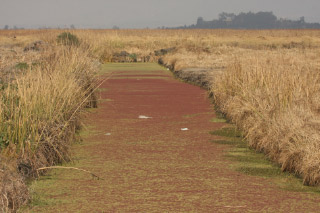 I first announce the next stop is an hour away, then reread my 2005 notes and
say it is 15 min., but later realize it is much longer. Actually, it is about 25
mi. stretched in time by a perpetuity of curves in a hairpin ascent to over
10,000 ft. through fir and pine forests and then a descent into a broad shallow
valley (8480 ft.) mostly removed of trees and now grasslands, farmlands, vacant
land and villages. I have trouble finding the access road to Lerma marshes and
when I finally do, I cannot find open water or wetlands. The area seems much
different from my previous visit. Now much of the wetlands have been converted
to cornfields and another crop that looks like beets or turnips. Narrow canals
have been dug around the edges of fields and we see a backhoe digging another.
The drained marshlands are now arid and dusty. The water surface in the canals
is sealed with duckweed, pond scum and, worse, is the dead cows and a dead cat
we find waterlogged in the canal. I think I prefer birding the garbage dump of
early morning to this depressing canal. Yet, we persist because we want to find
the Black-polled Yellowthroat, an endemic to these central Mexico mountain
valleys.
I first announce the next stop is an hour away, then reread my 2005 notes and
say it is 15 min., but later realize it is much longer. Actually, it is about 25
mi. stretched in time by a perpetuity of curves in a hairpin ascent to over
10,000 ft. through fir and pine forests and then a descent into a broad shallow
valley (8480 ft.) mostly removed of trees and now grasslands, farmlands, vacant
land and villages. I have trouble finding the access road to Lerma marshes and
when I finally do, I cannot find open water or wetlands. The area seems much
different from my previous visit. Now much of the wetlands have been converted
to cornfields and another crop that looks like beets or turnips. Narrow canals
have been dug around the edges of fields and we see a backhoe digging another.
The drained marshlands are now arid and dusty. The water surface in the canals
is sealed with duckweed, pond scum and, worse, is the dead cows and a dead cat
we find waterlogged in the canal. I think I prefer birding the garbage dump of
early morning to this depressing canal. Yet, we persist because we want to find
the Black-polled Yellowthroat, an endemic to these central Mexico mountain
valleys.
Finding several Common Yellowthroats is a good sign. We also find dozens of
Song Sparrows , a non-migratory subspecies that is much larger, more strikingly
marked and with an erect tail in contrast to our common U.S. version. Other
birds of the farmlands and ditches are Striped Sparrows, hundreds of Cattle
Egrets, many Marsh Wrens, a few Common Moorhens, a Horned Lark and a few Say’s
Phoebes and Violet-green Swallows. Absent, though, are the thousands of
blackbirds and hundreds of ducks, as well as rails and many more egrets and
herons. Persistent in our search, we scare up a female Black-polled
Yellowthroat, distinguished by its larger and more elongated size, duskier
yellow coloring and dark legs. We try to find the more attractive male, but do
not. We follow a female and then another – or the same, relocated – and
eventually everyone gets to see it, but not Jill even through we rearrange front
and back in our single file march over the uneven grass mounds along the dugout
canal.
, a non-migratory subspecies that is much larger, more strikingly
marked and with an erect tail in contrast to our common U.S. version. Other
birds of the farmlands and ditches are Striped Sparrows, hundreds of Cattle
Egrets, many Marsh Wrens, a few Common Moorhens, a Horned Lark and a few Say’s
Phoebes and Violet-green Swallows. Absent, though, are the thousands of
blackbirds and hundreds of ducks, as well as rails and many more egrets and
herons. Persistent in our search, we scare up a female Black-polled
Yellowthroat, distinguished by its larger and more elongated size, duskier
yellow coloring and dark legs. We try to find the more attractive male, but do
not. We follow a female and then another – or the same, relocated – and
eventually everyone gets to see it, but not Jill even through we rearrange front
and back in our single file march over the uneven grass mounds along the dugout
canal.
Turning around, I continue my search for open water and eventually find a bit
of marshland and a few ducks. By now we’ve consumed the time and must make the
long drive back to camp. The early morning at Huitzilac was exciting birding;
the Lerma marshes a disappointment.
(Shari) Such a nice relaxing day I have. I actually get caught up with
accounting, trip logs and journals. I even wash some things out by hand, take a
shower and clean up a bit. Bert will be surprised that I made something for
dinner too. About half in our group also enjoyed a lazy day at camp. Valerie did
some wash, Pat did some accounting and Bob went to Wal-Mart. I suppose some read
a book too. Bert comes back with the remainder of the group close to 5 and I am
surprised that many join us for social hour. I tell you this is a very social
group. We go inside for dinner and come out again at dark to sit by the huge
bonfire Umberto made for us. The fire is mesmerizing and I stay until only
glowing embers remain and I am the second last to leave.
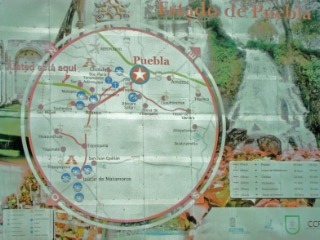 Day 17 – January 30 – Puebla, Puebla
Day 17 – January 30 – Puebla, Puebla
(Bert) “Two parrots just flew over the freeway and I’ve never seen any in
Cuernavaca”, I announce on the CB as I lead the caravan on the congested highway
through the city. I make mental notes of exactly what I saw and later I look up
the ranges of parrots. No parrots live in these central highlands, but the
overall size, deep wingbeats, absence of red and flock size point to
White-crowned Parrot. I wonder if these were escaped birds flying high above the
city.
(Shari) Today we are going to chart new territory again. This group is so
good at following directions that I am willing to try the toll road even though
I do not know where in Puebla it will dump us off. Most are willing to take
their turn as pod leaders, many know about as much Spanish as I do, and it
doesn’t seem as if anyone is afraid of the unknown. They all seem to trust us to
get them to the next spot and are very flexible and listen well.
The beginning of the trip is tedious since there is no toll road. Upon
entering the big city of Cuautla, Pod One and Pod Two take the charted route
through the congested city. Pod Three misses the turnoff and finds a brand new
bypass around the city. They shave 20 min. off the travel time and then wait for
us to join them while we communicate through our CB’s. Once out of the city we
easily find the toll road and now travel over smooth if not flat pavement. We
are traveling through open countryside, often climbing in elevation and, best of
all, we are bypassing many small towns and many more topes.
The fun starts when we reach Puebla and I do not know where the road
intersects the road we want. After the last tollbooth, we pull vehicles to the
side of the highway while I ask a taxi driver to guide us. By the time I walk
back to our rig, Pat says two taxis took off and they are nowhere to be seen. I
guess they will not get their 100 pesos. We stop again and ask some people at an
intersection. One of the girls speaks English and tells us to take the second
exit. We do and we find our place on the road log. Other wagonmasters have told
me that the signage is different from the descriptions in our log, so we
carefully try to remember how we did this last time. We take an exit, not really
knowing if it is correct or not. I am so sick to my stomach, I think I may throw
up. But Bert ways he remembers the scenery. I kind I do too, but wonder why we
did not have to make a returno as the log states. I need some affirmation and
tell him to pull off behind some police cars. I get out and ask the policemen
where Las Americas RV Park is located. They talk in rapid Spanish and I ask them
to guide me. We relate to the rest of the group that we are to be guided and we
follow the police car. He goes about 2 blocks, turns left and stops. I see the
sign for the RV park and we were within spitting distance all along. I give the
officer 50 pesos for his trouble and we tell the group to unhook their cars. The
street is full of traffic and honking horns that would make a snail nervous.
Bert and I unhook and go on ahead. I walk to the intersection and stop traffic
in one direction so that the caravan can make the left turn. Bert directs RV’s
to camping sites. Some do not know where to turn. Others do not know where to
park. Meanwhile, Mexicans are honking and trying to pass the group. Larry comes
up and parks his car perpendicular to the flow of traffic to block cars in each
direction. Some cars try to get around anyway. I stand in the middle to block
them and finally we have everyone off the road, if not in the campground. Many
ask me where they should park but I know that if I get involved with parking
Bert will holler at me. I tell them to have patience and wait their turn.
Finally we are settled; I can pay, inquire about Internet, inform the group, and
make margaritas for attitude readjustment. It works every time and after Bert
gives a talk on how to tell the subtle differences between some flycatchers of
the same genus, we snack and chat. After all the margaritas are gone, the group
disappears and Bert and I are left all alone. We too soon go inside as the night
is really cold. I think we may need two blankets tonight. The elevation here is
7019 ft., the highest campsite of our trip.
(Bert) I’m sure Shari will relate our travel experiences of today. Instead, I
want to comment on some of the e-mails I’ve received regarding stories in these
journals. The Pine Flycatcher sighting prompted questions and the Barn Owl
experiences generated stories from a couple of readers, one saying he will
postpone sending me a photo so as not to scare me more. Two other e-mails I’d
like to address here.
One believed we were hustled on Day 4 when the caretaker accepted money from
us for parking at the abandoned Pemex in San Roberto. Shari and I do not agree.
If it were a scheme, it would have been extremely elaborate, involving three
other Mexicans and a 3-year-old boy. To start with, the man simply did not want
us to stay at the property he was guarding. He didn’t want to accept money and
it was only after our urging to call his boss that a deal was struck. He had the
keys to the abandoned restaurant adjoining the Pemex where the boy was inside.
He told us his cell phone could not make long-distance calls and he had to
secure help from two others to learn how to use the phone card. We listened to
him make the call to Monterey and understood his side of the conversation. The
parking amount is a simple multiple times the number of rigs and an appropriate
amount for dry camping. Nothing in the entire transaction suggested fraud and in
the end it was entirely appropriate to us. So, don’t take this story as proof
that Mexicans are dishonest.
The second e-mail is from a long-time subscriber to our journals and a person
who once lived in the areas we have been traveling. He took note of the longer
hike we made on Day 12 at Sierra Chincua Biosphere Reserve to find the
butterflies and suggested that related to the deforestation problems in this
area. Shari and I have noticed that the butterflies have been in different
locations on each of our three visits (2003, 2005, 2009) but these are far apart
only from the perspective of someone hiking up and down steep hills at high
elevation. In fact, almost all of the area that we observed within the reserve
seems well preserved and maintained. Barbed wire fences block off parts of the
forest to promote further growth. In the immediate area where the horses are
kept and the number of concession shacks has expanded, the locals have been
trimming branches from the bushes to gather firewood for the fires they use to
prepare meals to sell. The weekend day we visited we were accompanied by many
Mexican tourists who also came to see the butterflies, a good sign that
ecotourism includes at least some of the Mexican population.
However, our reader is entirely right in noting the problems of deforestation
as it is quite obvious on the hillsides and the tree clearing continues to creep
up the mountains and selective cutting is occurring higher up. He provided an
excellent
link to photographs and aerial maps of
the devastation over time. He also mentions conversations with Lincoln
Brower, “who has spent his life trying to protect these refugia and he [Brower]
gives the overwintering Monarchs about 15 years before they and all habitat are
gone”.
In our travels this past couple of weeks we passed hundreds of hills and
mountains, brown in grass, brush and barren soil. Once and a while, we see a
very steep mountain that still is covered with tall trees. Certainly in the past
these mountains must have looked very different and I’m sure the birdlife that
depends on dense forests was more plentiful. Deforestation is a worldwide
problem and greatly affects not only wildlife, but also the increase in carbon
dioxide in our air, and it is closely tied to local poverty. Coincidentally, I
just read Thomas Friedman’s Hot, Flat, and Crowded where he discusses the
problem and in Chapter 13 describes some solutions that worked in Indonesia to
the benefit of all.
 Next
Day
Next
Day  Table
of Contents
Table
of Contents
 (Shari) I am thinking we are home free not realizing our hardest work is yet
to come. As we pull into the campground we notice it is full. I hop out of the
RV as Bert pulls to the far end with other rigs following. The manager tells me
to stop the caravan, it cannot come in. We do not have reservations. He shows me
his reservation sheet and I notice that the February caravan was indeed
cancelled but not ours. I try to explain this to him as he excitedly tells me to
leave. I have by now wasted enough time to allow the whole caravan off the road.
It does not look like we are going anywhere soon. We are all in the campground
and blocking every which way to Sunday. Realizing that I do not intend to tell
the caravan to leave, the manager calls his boss. I ask to talk with him. I
remember him from five years ago when he invited us to his goddaughter’s
wedding. I ask if we can park where he had the tent set up for the wedding. He
softens his attitude after I mention the wedding and says yes we can park there
if I can convince the other caravan. I am confident that I can and after I calm
down the French tailgunner from Quebec, assuring him that we will not take any
of his spaces, nor use electricity, he agrees to our parking. It would not have
mattered anyway, since Bert and Larry had begun the long process of inching us
into the spots.
(Shari) I am thinking we are home free not realizing our hardest work is yet
to come. As we pull into the campground we notice it is full. I hop out of the
RV as Bert pulls to the far end with other rigs following. The manager tells me
to stop the caravan, it cannot come in. We do not have reservations. He shows me
his reservation sheet and I notice that the February caravan was indeed
cancelled but not ours. I try to explain this to him as he excitedly tells me to
leave. I have by now wasted enough time to allow the whole caravan off the road.
It does not look like we are going anywhere soon. We are all in the campground
and blocking every which way to Sunday. Realizing that I do not intend to tell
the caravan to leave, the manager calls his boss. I ask to talk with him. I
remember him from five years ago when he invited us to his goddaughter’s
wedding. I ask if we can park where he had the tent set up for the wedding. He
softens his attitude after I mention the wedding and says yes we can park there
if I can convince the other caravan. I am confident that I can and after I calm
down the French tailgunner from Quebec, assuring him that we will not take any
of his spaces, nor use electricity, he agrees to our parking. It would not have
mattered anyway, since Bert and Larry had begun the long process of inching us
into the spots.  We drive to the top of the hill overlooking Tecámbaro and are impressed on
how nicely kept is this ecological park. A teacher is addressing a dozen school
girls under one of the shelters and a caretaker is working in another area.
Interestingly, all of the facilities are crafted to look like trees, even the
goal posts of a soccer field. Highlights of birding are Western Tanager,
Bullock’s Oriole
We drive to the top of the hill overlooking Tecámbaro and are impressed on
how nicely kept is this ecological park. A teacher is addressing a dozen school
girls under one of the shelters and a caretaker is working in another area.
Interestingly, all of the facilities are crafted to look like trees, even the
goal posts of a soccer field. Highlights of birding are Western Tanager,
Bullock’s Oriole From the coolness of the mountaintop pine forest we descend to the dry hot
cane fields along a deep and narrow ravine cut by a Rio Corucha. We stop for
lunch, but soon leave because the sun is too hot and the birds absent. Instead,
Georgia leads us to a birding spot I didn’t know about, a few miles beyond
Chupio. Arroyo Frio is a splendidly wooded ravine sporting a tall waterfall
plunging from a rock cliff. The waterfall feeds a swimming pool which
undoubtedly would be filled on weekends with local residents from the ejido that
built and maintains this facility, but today is vacant except for caretakers
operating a concession stand. In the comfort of the tall shade trees and some
drinking cervesa while sitting on the chairs that surround the pool, we study
the birds around us. A Squirrel Cuckoo makes a frequent appearance and several
White-throated Thrushes feed in the canopy as a pair of Rufous-backed Thrushes
browse in the leaf litter. We hear a Canyon Wren and later see it in the rocky
parts of the canyon. We wanted to see Russet-crowned Motmot and Golden-cheeked
Woodpecker, but find neither today although Georgia tells us they are regular
residents.
From the coolness of the mountaintop pine forest we descend to the dry hot
cane fields along a deep and narrow ravine cut by a Rio Corucha. We stop for
lunch, but soon leave because the sun is too hot and the birds absent. Instead,
Georgia leads us to a birding spot I didn’t know about, a few miles beyond
Chupio. Arroyo Frio is a splendidly wooded ravine sporting a tall waterfall
plunging from a rock cliff. The waterfall feeds a swimming pool which
undoubtedly would be filled on weekends with local residents from the ejido that
built and maintains this facility, but today is vacant except for caretakers
operating a concession stand. In the comfort of the tall shade trees and some
drinking cervesa while sitting on the chairs that surround the pool, we study
the birds around us. A Squirrel Cuckoo makes a frequent appearance and several
White-throated Thrushes feed in the canopy as a pair of Rufous-backed Thrushes
browse in the leaf litter. We hear a Canyon Wren and later see it in the rocky
parts of the canyon. We wanted to see Russet-crowned Motmot and Golden-cheeked
Woodpecker, but find neither today although Georgia tells us they are regular
residents.





 One of our sought after birds is Red Warbler and we get frequent, if brief,
looks at these bright red birds with white ear patches. Another warbler, rarer
and a life bird for some, is Golden-browed Warbler. Tom and I get good views of
one, including at 6 ft. range.
One of our sought after birds is Red Warbler and we get frequent, if brief,
looks at these bright red birds with white ear patches. Another warbler, rarer
and a life bird for some, is Golden-browed Warbler. Tom and I get good views of
one, including at 6 ft. range.  (Shari) Contracts mean little in Mexico. I have learned that and do not get
as upset as I used to. It is not a matter of totaling the number of rigs and
multiplying times the cost per night as stated on the contract. You can bet it
will be more. Just how much more depends on your ability to barter. Today is no
different. You would think that the park would be happy we squeezed ourselves in
without facilities. No, they not only want full price but a price higher than my
December 8 contract. I ask Roman, the manager, to call the owner. He holds fast
on the higher price but I negotiate the two nights without hookups at the lower
price. Two of our rigs had electricity and I must pay full for them. I say one
has only one person. Finally we settle on a price we both can live with, but I
hold a grudge. If there was an alternative I would take it. No competition here
is the problem. So after my money exchange I get all flustered and forget to
take binocs, hat and sunglasses on our boat outing to the island of Janitzio.
Fortunately, Charlu loaned me sunglasses and I bought a cute sun visor made from
straw for only $1.50.
(Shari) Contracts mean little in Mexico. I have learned that and do not get
as upset as I used to. It is not a matter of totaling the number of rigs and
multiplying times the cost per night as stated on the contract. You can bet it
will be more. Just how much more depends on your ability to barter. Today is no
different. You would think that the park would be happy we squeezed ourselves in
without facilities. No, they not only want full price but a price higher than my
December 8 contract. I ask Roman, the manager, to call the owner. He holds fast
on the higher price but I negotiate the two nights without hookups at the lower
price. Two of our rigs had electricity and I must pay full for them. I say one
has only one person. Finally we settle on a price we both can live with, but I
hold a grudge. If there was an alternative I would take it. No competition here
is the problem. So after my money exchange I get all flustered and forget to
take binocs, hat and sunglasses on our boat outing to the island of Janitzio.
Fortunately, Charlu loaned me sunglasses and I bought a cute sun visor made from
straw for only $1.50.  We board the Titanic in the fog; it does not go unnoticed by the group. Just
as we dock the fog dissipates and we have a gorgeous day to shop, climb the hill
to the statue and eat lunch. The picture that stays with me depicts a bit of
Mexico. As I am walking down the hundreds of uneven steps toward the dock, I see
a wheelchair. Down a bunch of steps is an old woman, seemingly blind and 100
years old, helped by a younger woman. They walk painstakingly slowly towards
that wheelchair and the younger woman has so much patience. “Necisita ayudar?” -
Do you need help - I ask. She smiles and looks up at me and says “No, gracias”.
I wonder where these two live, why they were climbing that hill and what is
their relationship. We in the U.S. seem to put our elderly in nursing homes. I
am no exception and think of my father. I am sad. On a happier note, at the
restaurant, I cannot decide whether to order my favorite whole fried fish or
chili relleno. They make the best rellenos here. I decide to order the fish and
get rellenos at the dock. You snooze you loose, so the saying goes. I try to buy
rellenos but the girl delays so long in packing them up that I tell her I must
leave. I have riders waiting for me. Betty and Jim take the prize for shopping.
Two big hats, T-shirts, etc., are in at least two bags that I see. I buy a beer
mug depicting “the dance of the old men”. I try to buy the rellenos at the
grocery store but no luck. I must have bemoaned the fact so much and sounded so
disappointed that Heather asks us to join her and Bob for dinner. Yum!
We board the Titanic in the fog; it does not go unnoticed by the group. Just
as we dock the fog dissipates and we have a gorgeous day to shop, climb the hill
to the statue and eat lunch. The picture that stays with me depicts a bit of
Mexico. As I am walking down the hundreds of uneven steps toward the dock, I see
a wheelchair. Down a bunch of steps is an old woman, seemingly blind and 100
years old, helped by a younger woman. They walk painstakingly slowly towards
that wheelchair and the younger woman has so much patience. “Necisita ayudar?” -
Do you need help - I ask. She smiles and looks up at me and says “No, gracias”.
I wonder where these two live, why they were climbing that hill and what is
their relationship. We in the U.S. seem to put our elderly in nursing homes. I
am no exception and think of my father. I am sad. On a happier note, at the
restaurant, I cannot decide whether to order my favorite whole fried fish or
chili relleno. They make the best rellenos here. I decide to order the fish and
get rellenos at the dock. You snooze you loose, so the saying goes. I try to buy
rellenos but the girl delays so long in packing them up that I tell her I must
leave. I have riders waiting for me. Betty and Jim take the prize for shopping.
Two big hats, T-shirts, etc., are in at least two bags that I see. I buy a beer
mug depicting “the dance of the old men”. I try to buy the rellenos at the
grocery store but no luck. I must have bemoaned the fact so much and sounded so
disappointed that Heather asks us to join her and Bob for dinner. Yum!


 (Bert) Shari is exhausted when I find her sitting on a three-legged stool
where the horses are gathered. I lead her to where I had been watching the
butterflies and enjoy them a second time. Others have begun the hike or ride
back and only Tom and Charlu are still here when Shari selects a horse to ride
back. She is very particular since she wants a thin horse which she thinks will
be easier to ride. As we move through the herd, dozens of Mexican boys each
encourage me to select their horse, speaking only Spanish except for the word
“horse”. When one of them attracts my attention by saying “Meester” I look at
his fine black horse and choose his. The other boys laugh and repeat the word,
sure now that is the reason I picked his. On the ride back, which progresses at
nearly three times the speed we walked earlier, the horse attendant leads or
follows, holding the reins. The horse breathes heavily, but the boy does not.
(Bert) Shari is exhausted when I find her sitting on a three-legged stool
where the horses are gathered. I lead her to where I had been watching the
butterflies and enjoy them a second time. Others have begun the hike or ride
back and only Tom and Charlu are still here when Shari selects a horse to ride
back. She is very particular since she wants a thin horse which she thinks will
be easier to ride. As we move through the herd, dozens of Mexican boys each
encourage me to select their horse, speaking only Spanish except for the word
“horse”. When one of them attracts my attention by saying “Meester” I look at
his fine black horse and choose his. The other boys laugh and repeat the word,
sure now that is the reason I picked his. On the ride back, which progresses at
nearly three times the speed we walked earlier, the horse attendant leads or
follows, holding the reins. The horse breathes heavily, but the boy does not.

 The cuota road to Taxco comes up sooner than I anticipate but we do NOT miss
it. Bert wants to stay on the cuota road longer than I do. I again tell him that
we do not know where it drops us off and we are exiting the cuota at a town I
recognize. We are back on the log clicking off points as the miles go by. We
come to a turn to Cuernavaca that does not seem right. It is too soon to show up
but then again it is not mentioned on our log. We have the choice of going to
Taxco or to Cuernavaca. We take the turn to Cuernavaca and then decide we are
wrong. Luckily only one other RV made the turn. All we have to do is make a
U-turn which Bert does easily, as does Gordon. Thank goodness for our small rig.
We recover and head to Taxco. It takes me 10 mi. to realize that we are not on
the road log yet again. No place to turn a caravan around on the steep winding
road to Taxco. For the next 30 mi. we are blazing a new trail again. I keep
wondering if this will put us on the cuota road to Cuernavaca. You can imagine
my relief when it does. Finally we are back on the log and heading down the
narrow gravel road through the field to our campground. Boy, do margaritas taste
good tonight!
The cuota road to Taxco comes up sooner than I anticipate but we do NOT miss
it. Bert wants to stay on the cuota road longer than I do. I again tell him that
we do not know where it drops us off and we are exiting the cuota at a town I
recognize. We are back on the log clicking off points as the miles go by. We
come to a turn to Cuernavaca that does not seem right. It is too soon to show up
but then again it is not mentioned on our log. We have the choice of going to
Taxco or to Cuernavaca. We take the turn to Cuernavaca and then decide we are
wrong. Luckily only one other RV made the turn. All we have to do is make a
U-turn which Bert does easily, as does Gordon. Thank goodness for our small rig.
We recover and head to Taxco. It takes me 10 mi. to realize that we are not on
the road log yet again. No place to turn a caravan around on the steep winding
road to Taxco. For the next 30 mi. we are blazing a new trail again. I keep
wondering if this will put us on the cuota road to Cuernavaca. You can imagine
my relief when it does. Finally we are back on the log and heading down the
narrow gravel road through the field to our campground. Boy, do margaritas taste
good tonight!  In my mind, the best finds are the flycatchers, not because they are the
prettiest but because they are the most challenging. In fact, to the novice eye
they all look identical. The subtleties are the slight differences in overall
coloring - from grayish to brownish to yellowish to greenish – the bill color,
the absence or presence of a crest and a few other easily overlooked
differences. Our flycatcher prizes today are Pileated
In my mind, the best finds are the flycatchers, not because they are the
prettiest but because they are the most challenging. In fact, to the novice eye
they all look identical. The subtleties are the slight differences in overall
coloring - from grayish to brownish to yellowish to greenish – the bill color,
the absence or presence of a crest and a few other easily overlooked
differences. Our flycatcher prizes today are Pileated


 Day 16 – January 29 – Huitzilac and Lerma marshes, D.F.
Day 16 – January 29 – Huitzilac and Lerma marshes, D.F.  I first announce the next stop is an hour away, then reread my 2005 notes and
say it is 15 min., but later realize it is much longer. Actually, it is about 25
mi. stretched in time by a perpetuity of curves in a hairpin ascent to over
10,000 ft. through fir and pine forests and then a descent into a broad shallow
valley (8480 ft.) mostly removed of trees and now grasslands, farmlands, vacant
land and villages. I have trouble finding the access road to Lerma marshes and
when I finally do, I cannot find open water or wetlands. The area seems much
different from my previous visit. Now much of the wetlands have been converted
to cornfields and another crop that looks like beets or turnips. Narrow canals
have been dug around the edges of fields and we see a backhoe digging another.
The drained marshlands are now arid and dusty. The water surface in the canals
is sealed with duckweed, pond scum and, worse, is the dead cows and a dead cat
we find waterlogged in the canal. I think I prefer birding the garbage dump of
early morning to this depressing canal. Yet, we persist because we want to find
the Black-polled Yellowthroat, an endemic to these central Mexico mountain
valleys.
I first announce the next stop is an hour away, then reread my 2005 notes and
say it is 15 min., but later realize it is much longer. Actually, it is about 25
mi. stretched in time by a perpetuity of curves in a hairpin ascent to over
10,000 ft. through fir and pine forests and then a descent into a broad shallow
valley (8480 ft.) mostly removed of trees and now grasslands, farmlands, vacant
land and villages. I have trouble finding the access road to Lerma marshes and
when I finally do, I cannot find open water or wetlands. The area seems much
different from my previous visit. Now much of the wetlands have been converted
to cornfields and another crop that looks like beets or turnips. Narrow canals
have been dug around the edges of fields and we see a backhoe digging another.
The drained marshlands are now arid and dusty. The water surface in the canals
is sealed with duckweed, pond scum and, worse, is the dead cows and a dead cat
we find waterlogged in the canal. I think I prefer birding the garbage dump of
early morning to this depressing canal. Yet, we persist because we want to find
the Black-polled Yellowthroat, an endemic to these central Mexico mountain
valleys.  Day 17 – January 30 – Puebla, Puebla
Day 17 – January 30 – Puebla, Puebla